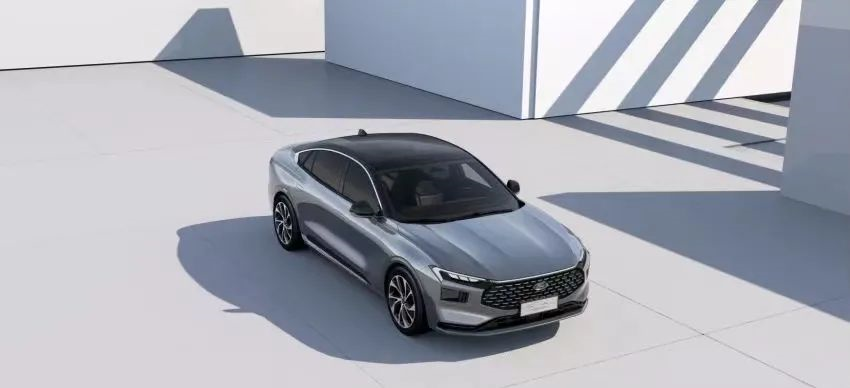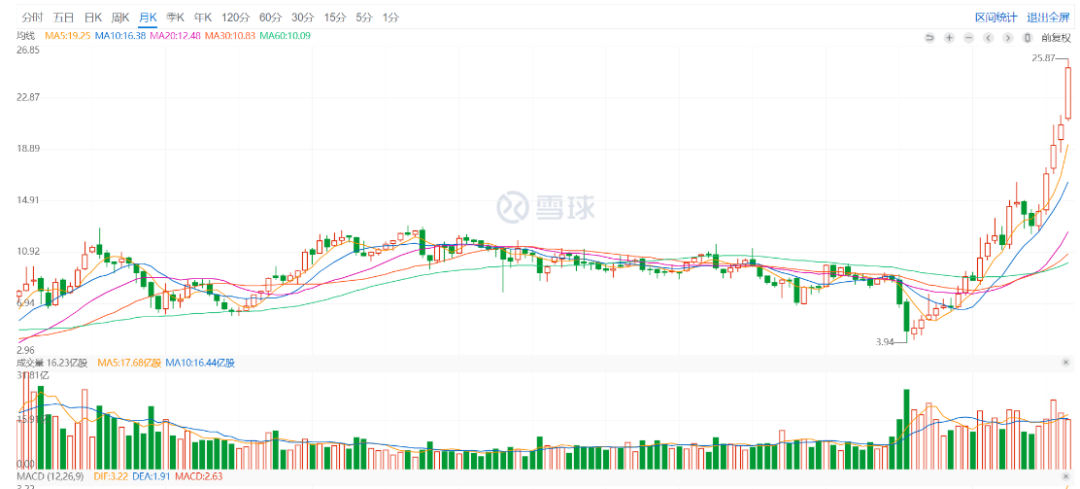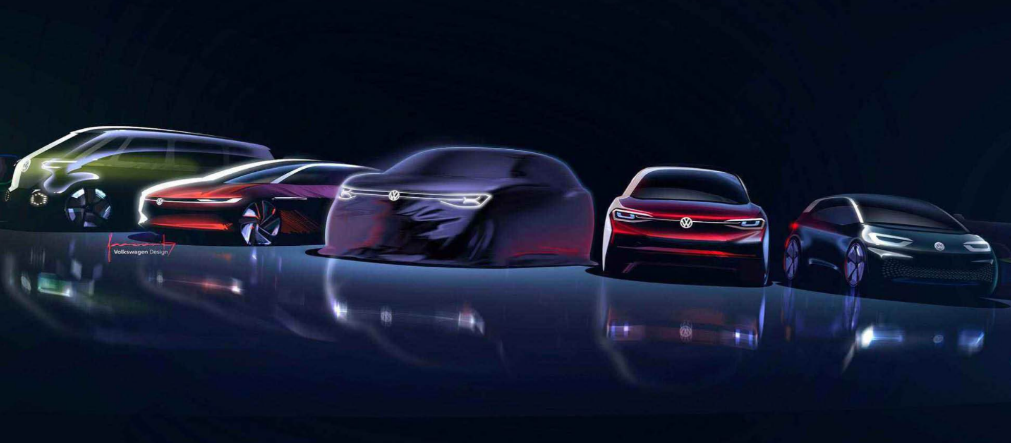*This article is reproduced from the Autocar Weekly WeChat account.
Author: Financial Street Laoli
The change in Ford’s market value has significant implications for the valuation reshaping of global car companies.
Last night, Ford Motor Company unveiled the all-new generation of Mondeo at the Ford China Design Center, showcasing Ford’s determination and speed in self-evolution through the new design language “Kinetic Aesthetics” to Chinese users. In the past 2021, Ford China achieved its best performance in nearly three years.

In Laoli’s opinion, compared to the improvement in performance, Ford’s market value is more impressive. Last week, Ford’s market value exceeded 100 billion US dollars, creating the company’s highest market value in history, and surpassed General Motors and Fiat-Chrysler to become the highest market value among traditional American car companies. In 2021, Ford’s market value increased nearly 1.5 times with growth exceeding that of many US-listed companies, such as Tesla, General Motors, and NIO.

It should be noted that in the past year, in addition to Ford, companies such as General Motors, Fiat-Chrysler, and Toyota also had good market value performances. Since the end of 2020, the market has once again brought new valuation methods to car companies after Tesla and NIO. Today, Laoli will talk with you about what happened to Ford in this year and how to view the valuation methods of traditional car companies. What are the implications for Chinese car companies?
What happened to Ford this year?
In the capital market, foreign car companies and domestic car companies have different analysis methods. It is impossible to analyze Ford Motor Company from the perspective of A-shares. First, Ford is a global car company, and its strategy and global performance must be viewed from a global perspective. Second, Ford is an American stock company, and the valuation method of the US stock market is very different from that of A-shares. Although the analysis methods are slightly different, the fundamentals must be considered for the market value trend of any listed company. In the past year or so, the fundamental reason for the market value growth of US-listed car companies, including General Motors and Toyota, is that the company’s fundamentals have undergone significant changes, and in the transformation of intelligent electric vehicles, American capital led by Wall Street has begun to pay attention to local companies.## Ford’s Performance in 2021: Steady Fundamentals and Accelerated Electrification
In 2021, Ford’s fundamentals have been steadily improving. Although the full-year financial report has yet to be released, the Q3 report showed that Ford achieved its best financial performance in nearly three years. Its revenue for the first three quarters of the year was $98.663 billion, a year-on-year increase of 8.19%. Its full-year revenue is expected to exceed $140 billion, a slight increase from the previous year. Although revenue has not changed significantly, Ford’s adjusted pre-tax profit for the full year of 2021 is expected to be between $10.5 billion and $11.5 billion, which greatly exceeds the expectations of the capital market.
Despite receiving a good rating from the capital market, Ford’s market-sales ratio is still less than 1 (total market value/main business revenue), which not only is lower than NIO, but also far lower than Tesla. It is at a similar level to General Motors. As a company with a revenue of over $130 billion, its market value has just exceeded $100 billion. This reflects that the capital market’s expectations for traditional automakers are still not as good as those of new forces.
The performance of the capital market is essentially a reflection of business performance and expectations. In 2021, both business performance and expectations for Ford, both in China and globally, were impressive compared to the previous year.
This year, Ford’s performance in the Chinese market rebounded. Ford sold nearly 625,000 vehicles in China (including imports), a year-on-year increase of 3.7%. Although the absolute number is not large, Lincoln brand’s annual sales reached 91,600 vehicles, a year-on-year increase of 48.3%, achieving a record high in annual sales since its entry into China, and steadily catching up with the second-tier luxury brands. Although Ford’s performance in China does not have a significant impact on its market value, it is a reflection of Ford’s global transformation taking effect.
To Mr. Li, the fundamental reason why Ford’s market value increase is leading that of GM and Toyota is due to its accelerated electrification in the United States. In 2021, Ford surpassed GM and became the second-largest seller of electric vehicles in the United States, second only to Tesla. In the North American market alone, after the fourth quarter, the average monthly sales volume of Ford electric vehicles stabilized at over 10,000 units, comparable to the sales volume of NIO, and is expected to exceed 20,000 units per month in 2022.
As with Jobs and Cook, Wall Street investors value company leaders very highly when investing money. The reason why traditional automakers are traditional is mainly due to their management.# Ford is lucky
Ford has been fortunate since October 2020 when Jim Farley took the helm as the new president. Farley initiated a radical reform and advanced the “Ford +” restructuring plan, which shifted more resources to the electrification transformation based on the electric vehicle strategy of the former president Jim Hackett. Ford’s financial reports have also become more transparent.
Jim Farley is regarded as a capital expert by his colleagues, for he has achieved a growth rate of over 200% in Ford’s stock market value after serving for only one year. Farley is good at dealing with the media and capital, conducting capital marketing by guiding public opinion, similar to Musk and Li Bin. Last year, Farley stated that the annual output of Ford Mustang Mach-E would double to 200,000 vehicles by 2023. With this news alone, Ford’s market value increased by nearly 10%.
How to evaluate the valuation of electric vehicle companies?
Talking about the market value of car companies, it is necessary to make horizontal and vertical comparisons. From either the temporal or inter-business dimensions, Ford has a lot to say. Based on these comparisons, Old Li vaguely feels that the position of traditional car companies in the US market is changing.
Since the middle of the year before last, the whole vehicle sector of A-shares market in China has opened up good trends, especially private enterprises represented by Great Wall Motors performed well in the market, and the market value of new energy vehicle enterprises represented by BYD is approaching one trillion RMB. In addition to the performance of the three major US auto companies in the US stock market this year, many people are discussing whether the valuation logic of automotive companies has changed.
Since the emergence of a batch of new forces in car manufacturing, such as Tesla and WmAuto, the global automotive industry has a distinction of “new forces” and “traditional car companies”. Looking ahead in 10 years or even longer, the new forces are no longer new, and traditional car companies may be bankrupt or may be reborn. Therefore, whether it is a new force or a traditional car company, it depends on whether they acknowledge the “way” of the capital market.
The essential reason for the high valuation of tech stocks in the US market is that everyone acknowledges the future of tech stocks. The market will give higher valuations to any imaginatively promising track. Smart electric vehicles are just such a track. The global capital market believes that smart electric vehicles will have huge market space in the future.Under this big logic, two different market valuations have emerged between new forces and traditional car companies: Intelligent electric vehicle companies represented by Tesla and WM Motor have extremely high market sales rates due to the overly optimistic market, leading to overvaluation; while traditional fuel vehicle companies represented by Toyota, Volkswagen, and Ford have extremely low market sales rates, despite their outstanding revenue, because they are not in the intelligent electric vehicle race, so the market cannot give them corresponding valuations based on the logic of intelligent electric vehicle companies.
However, since last year, traditional companies represented by Ford have entered the “road” of intelligent electric vehicles, and Wall Street capital is not stupid. Although many traditional car companies have announced their transformation, there are not many companies that dare to go all in, and Ford is one of them. Just as one should not listen to what a man says but pay attention to what he does, the same is true for car companies. Do not listen to what enterprises say, but watch what they do.
When overseas companies were still announcing their transformation, Ford’s F-150 Lightning, E-Transit, and Mach-E had been successively delivered to the market with good sales performance, which should have received the overvaluation of intelligent electric vehicle companies. What’s more interesting is that Ford will also call out. Ford expects to invest between $40 billion and $45 billion in strategic capital expenditures from 2020 to 2025, including more than half of the previously announced $30 billion of electrification investments during this period. These are almost all in the new four modernizations, with the cushion of performance and market expectations, the capital market will naturally give a higher valuation.
The researchers’ logic is also simple. In the United States, a country that is not very enthusiastic about intelligence, as long as the focus is on electrification and user preference, it is highly likely to achieve good market performance. Ford’s electric pickup truck has the most market opportunities. In the opinion of Lao Li, the US market no longer distinguishes between so-called new forces and traditional car companies. As long as there are enterprises that go all in on intelligent electric vehicles and have good market performance, they will have good valuations.
Inspiration from Ford’s Market Value for China?
In a previous article, Lao Li described China’s new energy vehicle industry as follows: In the first half of the game, China took the lead in electrification and approached parity in intelligentization. Now, the second half of the game has just begun. Intelligentized companies such as Nvidia and Intel are still leading, and in terms of electrification, US automakers Ford and General Motors are following closely. China’s intelligent electric vehicle companies seem to have a bright future, but they also hide risks.To be honest, the three major American car companies are all very competitive. As a century-old enterprise, they have experienced various difficulties and challenges such as war, self-iteration, and financial crises. Even in the 21st century, during the great transformation in the automotive industry, American car companies did not back down. On the contrary, they slowly emerged from the trough.
Among the three enterprises, Ford is considered by Lao Li to be the most innovative and resilient. From the Model T to the assembly line production, from oil shortages to financial crises, Ford has been innovating in the midst of change. The accumulation of overseas car companies over nearly a century is not possessed by Chinese car companies, let alone the entire Chinese automotive industry. In the 30 years of the new four modernizations, Chinese companies have created a leading advantage, but it is a long-term battle and the road is still long.
Recalling the year 2008, Ford Motor Company began large-scale restructuring and structural adjustment, vigorously reducing costs and focusing on core brand construction, and continuously launching new car products in the depressed market and harsh financing environment. These measures achieved obvious results, thereby surviving the global financial crisis in 2008 and making it the only company among the three major American car manufacturers that did not apply for government assistance.
Three years ago, Ford fell behind in both the intelligent electric transformation and traditional car competition. However, in just three years, Ford China launched a ambitious reform, and the electrification and intelligent transformation in China are also accelerating. The first global strategic model of “Ford China 2.0” plan EVOS and Mach-E, which is locally produced, have been put into mass production, and the new generation of Mondeo also debuted last night.
In October last year, Ford launched the new Ford Select high-end intelligent electric vehicle exclusive brand in China. It is not easy for an independent electric vehicle brand to be established. As we all know, a certain European manufacturer encountered resistance in the board of directors when upgrading its electric vehicle series to a single brand.
According to the classification method of Chinese capital market, Ford Motor belongs to value stocks, similar to Guizhou Maotai and Wuliangye. However, most Chinese whole vehicle companies and new energy industry chain leading companies belong to growth stocks, such as BYD, CATL, etc. Chinese companies lack a century-old heritage, and the length of the smart electric vehicle racecourse will determine the height of the enterprise.马云说,阿里巴巴要做三个世纪的企业,也曾调侃教育产业会一直在,而新东方却不会一直在。汽车行业也是一样,福特汽车已经拥有超过 110 年的历史,在时代的大浪淘沙中,中国车企需要经历更多的风浪,汽车产业很难出现行业颠覆性的变革,众多百年的企业在提示我们,唯有在变革中迭代,在迭代中壮大,企业才能保持生机。
This article is a translation by ChatGPT of a Chinese report from 42HOW. If you have any questions about it, please email bd@42how.com.
